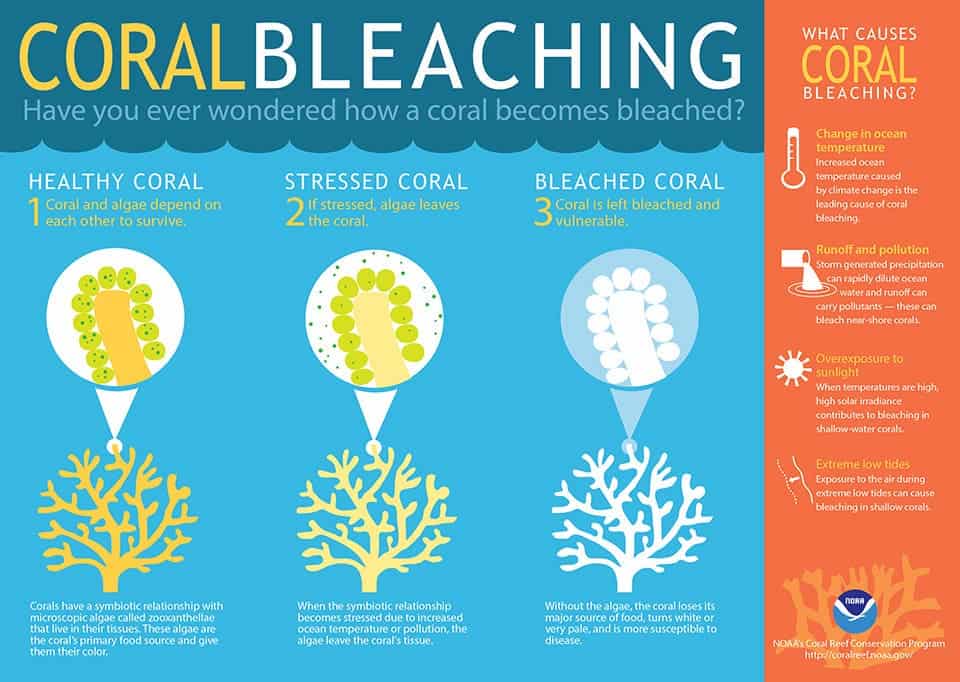Coral populations are crucial to the health of oceanic environments, but they are also extremely vulnerable to changing conditions. Researchers warn that warming waters and ocean acidification lead to coral bleaching which can cause massive damage across both the Atlantic and the Pacific.

Despite their appearance, corals are animals and not plants. They typically live in compact colonies of many identical individual polyps, secreting calcium carbonate to form a hard skeleton. Many corals from and rely on a symbiotic relationship with a class of algae. Via photosynthesis, these provide energy for the coral, and aid in calcification and as much as 30% of the tissue of a polyp may be plant material. In return, the algae benefit from a safe place to live and consume the polyp’s carbon dioxide and nitrogenous waste. All is fine as long as the coral is fine, but if the coral becomes stressed, then it can eject the algae, either through expulsion or loss of algal pigmentation – this is called coral bleaching, and it’s a major issue. Warming waters are especially threatening, as the National Oceanic and Atmospheric Administration (NOAA) explains:
“Warmer water temperatures can result in coral bleaching. When water is too warm, corals will expel the algae (zooxanthellae) living in their tissues causing the coral to turn completely white. This is called coral bleaching. When a coral bleaches, it is not dead. Corals can survive a bleaching event, but they are under more stress and are subject to mortality.”
As unusually warm temperatures are sweeping through the equatorial Pacific, north Pacific and western Atlantic oceans coral bleaching is taking worrying proportions.

“The bleaching that started in June 2014 has been really bad for corals in the western Pacific,” said Mark Eakin, NOAA’s Coral Reef Watch coordinator, in a news release on Monday. “We are worried that bleaching will spread to the western Atlantic and again into Hawaii.”
Much of this warming can be blamed on El Nino’s weather patterns, but this warming started way before – El Nino is only the accentuating factor. The frequency of this kind of events also indicates that overall warming is more of a concern than individual weather patterns.
“We’re seeing an actual progression that goes along with this sort of big event, but it’s happening without a huge El Nino,” he said. “We’re seeing the more frequent return of these events primarily because the water temperature without an El Nino is already so warm it takes less … to tip the scales and cause the corals to bleach.”
Earlier this year, NOAA’s Coral Reef Watch four-month Coral Bleaching Outlook accurately predicted coral bleaching in the South Pacific and in 2014, Hawaii saw widespread coral bleaching for the first time since 1996. If it also happens again this year, it would be the first time in recorded history that this would happen two years in a row. This adds even more pressure, because while some corals may survive the bleaching, they need time to recover.
“Many healthy, resilient coral reefs can withstand bleaching as long as they have time to recover,” Eakin said. “However, when you have repeated bleaching on a reef within a short period of time, it’s very hard for the corals to recover and survive. This is even worse where corals are suffering from other environmental threats, like pollution or overfishing.”
Now, in a new study, NOAA researchers express their concerns once again – if we don’t do something to drastically curb our CO2 emissions, then coral populations will suffer.
“The paper reports that even if humans limit the Earth’s warming to two degrees C (3.8 degrees F), many marine ecosystems, including coral reefs, are still going to suffer,” said Eakin, an author on the paper. “The increase we are seeing in the frequency and severity of bleaching events is part of why the climate models in that paper predict a dire future for coral reefs.”
Journal Reference: J.-P. Gattuso et al. Contrasting futures for ocean and society from different anthropogenic CO2 emissions scenarios. Science 3 July 2015: Vol. 349 no. 6243. DOI: 10.1126/science.aac4722


